Health Care Waste | Medical Science Optional Notes for UPSC PDF Download
Introduction
Health care waste refers to the waste produced by healthcare establishments, research facilities, and laboratories as a result of various healthcare activities.

Bio-medical waste management Rules, 2016
The introduction of the 2016 Bio-medical Waste Management Rules marks a shift from the Biomedical Waste (Management and Handling) Rules of 1998. Released by the Environment Ministry, these new rules establish a broader and more comprehensive framework for the management of bio-waste. The updated regulations simplify categorization and authorization, signaling a significant change in how the country handles biomedical waste. This alteration is expected to have a substantial impact on the Clean India Mission.
Salient features-Bio-medical waste management Rules, 2016
(a) The scope of the regulations has been broadened to encompass vaccination camps, blood donation camps, surgical camps, or any other healthcare activities.
(b) Phasing out the use of chlorinated plastic bags, gloves, and blood bags is mandated within a two-year period.
(c) Pre-treating laboratory waste, microbiological waste, blood samples, and blood bags through on-site disinfection or sterilization, following the guidelines prescribed by WHO or NACO.
(d) Providing training to all healthcare workers and ensuring regular immunization of health workers.
(e) Establishing a Bar-Code System for bags or containers containing biomedical waste for disposal.
(f) Reporting major accidents as per the new rules.
(g) The updated rules set more stringent standards for incinerators to reduce pollutant emissions into the environment.
(h) Existing incinerators must meet standards for retention time in the secondary chamber and Dioxin and Furans within two years.
(i) Biomedical waste has been reclassified into four categories instead of ten to enhance waste segregation at the source.
(j) The authorization process has been simplified, with automatic authorization for bedded hospitals. The validity of authorization is synchronized with the validity of consent orders for bedded healthcare facilities, and non-bedded healthcare facilities receive one-time authorization.
(k) No occupier is allowed to establish an on-site treatment and disposal facility if a 'common biomedical waste treatment facility' is available within a distance of seventy-five kilometers.
(l) Operators of common biomedical waste treatment and disposal facilities are required to ensure timely collection of biomedical waste from healthcare facilities and assist in conducting training for healthcare facilities.
Bio-medical waste management Rules 1998 vs 2016

Bio-medical waste management (Amendment) Rules, 2018
Key Points:
- By March 27, 2019, bio-medical waste generators must phase out the use of chlorinated plastic bags and gloves.
- The amended BMW rules of 2018 exclude blood bags from the phase-out requirement.
- All healthcare facilities are required to publish their annual reports on their websites within two years of the publication of the Amended Rules in 2018.
- Operators of common bio-medical waste treatment and disposal facilities must implement bar coding and a global positioning system for bio-medical waste handling, aligning with guidelines from the Central Pollution Control Board by March 27, 2019.
- State Pollution Control Boards are tasked with collecting, reviewing, and analyzing information, submitting it to the Central Pollution Control Board using a new detailed Form. This form includes data on district-wise bio-medical waste generation, information on Health Care Facilities with captive treatment facilities, and details about common biomedical waste treatment and disposal facilities.
- Every occupier, referring to a person with administrative control over the institution and premises generating biomedical waste, must pre-treat laboratory waste, microbiological waste, blood samples, and blood bags on-site through disinfection or sterilization. This process should follow guidelines from the WHO or guidelines on safe waste management from healthcare activities, and the WHO Blue Book 2014. After pre-treatment, the waste is then sent to a common bio-medical waste treatment facility for final disposal.
Bio-medical waste management (Amendment) Rules, 2019
On March 19, 2019, the Central Government issued notification G.S.R. 129(E), publishing the Bio-Medical Waste Management (Amendment) Rules, 2019 in the electronic gazette.
The main points of the revised rules are outlined below:
The person in charge of all bedded healthcare units is required to consistently maintain and update the biomedical waste management register on a daily basis. Monthly records of waste disposal management must be visibly displayed on the website of all bedded healthcare units. Regardless of the number of beds, such healthcare facilities are obligated to provide their Annual Report on their website by March 19, 2021. Health care facilities with fewer than ten beds must adhere to the output discharge standard for liquid waste by December 31, 2019.
Sources of Health Care waste
- Public and private hospitals
- Healthcare facilities
- Medical practices (Physicians and dentists)
- Medical dispensaries
- Primary Health Centers (PHCs)
- Institutions for medical research and training
- Mortuaries
- Blood banks and collection centers
- Animal housing facilities
- Slaughterhouses
- Laboratories
- Vaccination centers
- Biotechnology institutions/production units
Health hazards of health care waste

Principles of Medical Waste Management
Waste Reduction:
- Educating employees can influence their behavior, promoting mindfulness about waste production and proper segregation to lessen the burden on downstream treatment processes.
- Waste management programs should prioritize facility operations, especially those generating the most waste.
- Healthcare managers can minimize waste production by adapting purchasing and stock control strategies.
- Inventory control techniques, such as more frequent ordering of smaller quantities, can reduce inventory levels and the risk of product expiration. Using the oldest items first, ensuring complete use of every container, and monitoring expiration dates can also help prevent excess product accumulation.
Avoid Mixing Different Types of Waste:
- Post-generation handling can prevent unnecessary dilution or mixing of waste.
- Combining multiple types of physical or chemical waste in the same batch increases the demands on the treatment or disposal system.
Source Segregation (Proximity Principle):
- Implementation at both ward and unit levels is crucial.
- Proximity to waste segregation enhances effectiveness.
- Color coding supports segregation at the source.
Safe Transportation:
- Waste segregates should be transported safely to the pickup site.
- While a negative air pressure system can be expensive, it helps minimize the risk of waste release during transportation.
Categorization and Treatment and Disposal Technologies
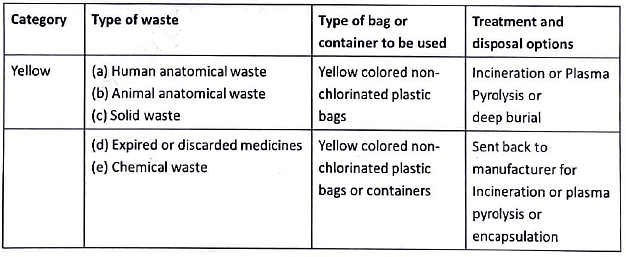




Incineration
- A high-temperature dry oxidation process that transforms organic and combustible waste into inorganic incombustible matter, with the following specifications:
(a) Moisture content should be below 30%.
(b) Combustible matter should exceed 60%.
(c) Non-combustible solids should be less than 5%. - Waste types unsuitable for incineration include:
(a) Pressurized gas containers.
(b) Large amounts of reactive chemical wastes.
(c) Silver salts, photographic or radiographic wastes.
(d) Halogenated plastics like PVC.
(e) Waste with high mercury or cadmium content, such as broken thermometers, used batteries, and lead-lined wooden panels.
(f) Sealed ampules or ampules containing heavy metals. - Various types of incinerators include:
(a) Double-chamber pyrolytic incinerators, specifically designed for burning infectious healthcare waste.
(b) Single-chamber furnaces with a static grate, recommended only if pyrolytic incinerators are not economically viable.
(c) Rotary kilns operating at high temperatures capable of decomposing genotoxic substances and heat-resistant chemicals.
Incineration-Standards and Precautions
- Chemical pretreatment prior to incineration is not required.
- Incineration of chlorinated plastics is not recommended.
- Operating standards mandate a combustion efficiency of 99.00%, a primary chamber temperature of at least 800 degrees Celsius, a secondary chamber temperature of at least 1050 degrees Celsius or -50 degrees Celsius, and a minimum stack height of 30 meters above the ground.
- Ash resulting from the incineration of biomedical waste should be disposed of at a common hazardous waste treatment and disposal facility.
- Incineration serves the dual purpose of reducing both the toxicity and volume of the waste, which is crucial when the final destination for waste disposal is landfills. It is estimated that a single incinerator could handle approximately 10,000 beds or an equivalent of around 5000 kg/day.
Incineration-Simplified flow scheme
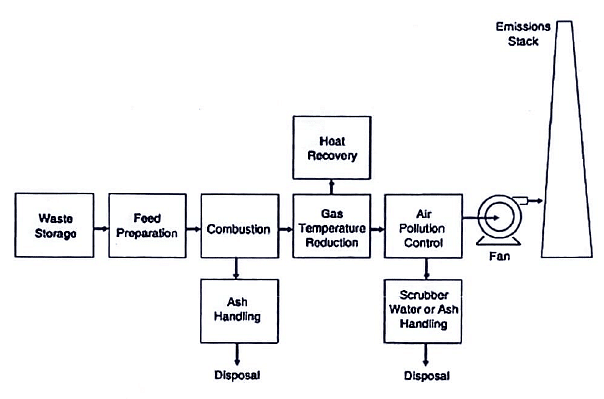
Plasma Pyrolysis or Gasification
- This process involves the use of extreme thermal conditions, utilizing a plasma torch powered by an electric arc. In this method, plasma transforms organic matter into syngas (a synthesis gas composed of hydrogen and carbon monoxide) along with a byproduct slag.
- The waste undergoes heating, melting, and vaporization, processes achievable only under these extreme conditions where molecular dissociation occurs by breaking molecular bonds. Complex molecules are separated into individual atoms, resulting in gaseous-phase elemental components known as syngas. This process is termed "plasma pyrolysis."
- The temperature in the combustion chamber following plasma gasification should be maintained at 1050 ± 50 degrees Celsius, with a gas residence time of at least 2 seconds and a minimum of 3% oxygen in the stack gas.
- Combustion Efficiency (CE) must reach a minimum of 99.99%.
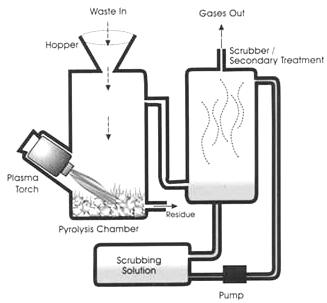
Incineration vs Plasma Pyrolysis

Encapsulation (Inertization)
- Encapsulation entails immobilizing pharmaceuticals within a solid block contained in a plastic or steel drum.
- Prior to use, drums must undergo cleaning and should not have previously held explosive or hazardous materials.
- These drums are filled up to 75% capacity with solid and semi-solid pharmaceuticals, and the remaining space is occupied by a medium such as cement, cement/lime mixture, plastic foam, or bituminous sand through pouring.
- After reaching 75% capacity, a mixture of lime, cement, and water in the proportions 15:15:5 (by weight) is added, and the drum is filled to capacity.
- Occasionally, a larger quantity of water may be necessary to achieve a satisfactory liquid consistency.
- Ideally, steel drum lids should be sealed through seam or spot welding.
- Sealed drums should be positioned at the base of a landfill and covered with fresh municipal solid waste.
- For ease of transportation, drums may be placed on pallets, which can then be loaded onto a pallet transporter.
Other methods
Autoclave
- Autoclaves, also known as pressure chambers, are employed for the sterilization of medical waste by exposing them to pressurized saturated steam at 121 degrees Celsius for approximately 15-20 minutes.
- Autoclaving is frequently used to sterilize medical waste before its disposal in the standard municipal solid waste stream.
- This method has gained popularity as an alternative to incineration, primarily due to environmental and health concerns arising from the combustion by-products emitted by incinerators, especially smaller units commonly operated at individual hospitals.
Microwave
- The action of microwaves, operating at a frequency of about 2450 MHz and a wavelength of 12.24 cm, effectively destroys most microorganisms.
- Microwaves rapidly heat the water present within the waste, leading to the destruction of infectious components through heat conduction.
- The efficacy of microwave disinfection should be regularly assessed through bacteriological and virological tests.
Sanitary Landfills
Sanitary landfills are designed to offer at least four advantages over open dumps:
- Geological isolation of waste from the environment.
- Appropriate engineering preparation before the site is ready to receive waste.
- On-site staff presence to control operations.
- Organized deposition and daily coverage of waste.
Deep burial-Standards
- Excavate a pit or trench to a depth of approximately two meters. Fill it halfway with waste, cover it with lime up to 50 cm from the surface, and then complete the filling with soil.
- Ensure that burial sites are inaccessible to animals; employ covers made of galvanized iron or wire meshes if necessary.
- After each addition of waste to the pit, cover it with a 10 cm layer of soil.
- Carry out burial activities under vigilant and dedicated supervision.
- Choose a deep burial site with relatively impermeable characteristics, and keep it away from shallow wells.
- Locate the pits at a distance from habitation, ensuring no contamination of surface water or groundwater. The chosen area should not be susceptible to flooding or erosion.
- Obtain authorization from the prescribed authority for the location of the deep burial site.
- Maintain a record of all pits used for deep burial at the institution.
- Ensure that the groundwater table level is a minimum of six meters below the lower level of the deep burial pit.

Standards for liquid waste
The effluent produced or processed on the premises of the occupier or operator of a common biomedical waste treatment and disposal facility must adhere to the following limits before being discharged into the sewer.
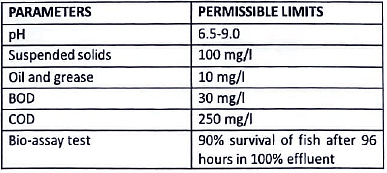
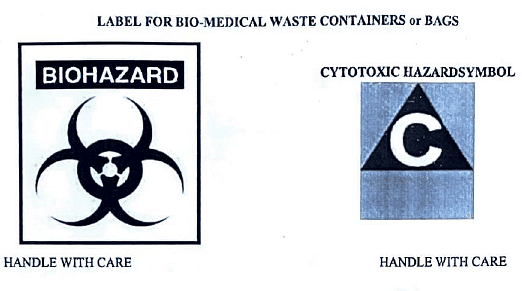
Chemical Disinfection:
- Leads to disinfection rather than sterilization.
- Appropriate for liquid waste.
- Solid wastes can also undergo disinfection but with certain limitations.
Wet and Dry Thermal Treatment:
- Wet thermal treatment, or steam disinfection, closely resembles the autoclave process, utilizing high-temperature, high-pressure steam.
- Dry thermal treatment, employing screw-feed technology, is a non-burning process utilizing a rotating auger and is suitable for infectious waste and sharps.
Hospital waste management-Repeats
- Describe the management of Biomedical Waste. (2010)
- What are the principles of hospital waste management? Describe the various treatment and disposal technologies for biomedical waste. (2014)
|
7 videos|236 docs
|
FAQs on Health Care Waste - Medical Science Optional Notes for UPSC
| 1. What are the sources of health care waste? |  |
| 2. What are the health hazards associated with health care waste? |  |
| 3. How is health care waste categorized and treated? |  |
| 4. What is the difference between incineration and plasma pyrolysis for health care waste disposal? |  |
| 5. Which method is better for health care waste disposal, incineration, or plasma pyrolysis? |  |





















